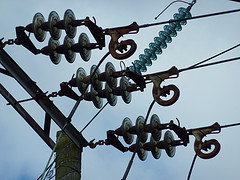
Imagine a parallel universe (or state) where oxygen isn’t freely available but is a product available for sale on the market. Those responsible for that market are asked to ensure the market is efficient.
The oxygen market is wonderfully efficient. Lots of businesses make money selling oxygen and getting it to people’s homes. Only 18,000 NSW households are disconnected from oxygen due to non-payment.
We don’t talk about how much it costs the community to provide oxygen tanks so people don’t gasp for breath. We don’t change the market rules so those in charge have to consider the social impacts of high oxygen prices.
Counting those costs would mean admitting the market isn’t so efficient after all. Sure, it’s an essential service but the social safety net will keep people connected.
Welcome to the discussion on electricity prices in 2012, where vociferous political debate on electricity pricing is cold comfort to those struggling to stay connected to their energy supply.
Last week’s announcement that a Senate Committee would investigate electricity prices could be good news for vulnerable electricity consumers.
But the Committee has a herculean task ahead: they have ten weeks to come together, investigate 17 thorny and complex topics, receive and review submissions, and produce a written report. It’s tempting to be sceptical about whether this will really lead to comprehensive reform for those struggling to pay their energy bills.
We have been conducting research among vulnerable people’s access to energy. The research confirms that anxiety about electricity price rises is at an all-time high.
Barry (not his real name) relies on a motorised wheelchair. He’s so worried about rising electricity prices that he now hardly goes out, he rations his TV use and if friends visit he worries how long they will stay because he doesn’t know if he can pay the cost of running the heating for them.
Like Barry, many people simply can’t keep up with prices that are rising much faster than the assistance offered to vulnerable people.
You may be surprised to learn that the social impacts of rising electricity prices are not taken into account when electricity prices are being set.
The objective guiding the rule makers and the network price regulators requires that the market develops efficiently and works in the long-term interest of consumers with regard to price, quality, safety, reliability and security of supply.
A large commercial business can recoup costs outlaid on electricity by increasing the price of its products and services. By contrast, residential consumers (or, as we like to call them, ‘people’), must absorb rising electricity costs as a growing percentage of their income.
This leaves a growing number of people at risk of disconnection. If you rely on electricity to run life-support equipment at home, or to provide basic heating, you can end up facing terrible choices about where to cut back.
But it doesn’t have to be like this. State and federal governments could insist that regulators consider energy as an essential service when making their decisions that set or affect prices.
Improvements will take planning, political will and a genuine desire not to exclude people from the electricity market where they have an inability to pay.
Disappointingly, the Federal Government’s 291-page draft Energy White Paper includes just three paragraphs under the subtitle ‘Addressing the rising costs of energy’. Instead, it focuses predominantly on energy security.
When discussing vulnerable households, the draft suggests the most efficient way to deal with affordability is through a social safety net and not by market interventions.
We shouldn’t design a market solely for the most vulnerable if they can be assisted by other means. Similarly, we shouldn’t overstate the ability of any social safety net to respond to rapid, sizeable and continuing price increasesespecially when making policy about an essential service.
As the system stands today, the social impacts of high electricity prices are seen as largely irrelevant.
So let’s make them relevant. If we are going to rely on the safety net to keep people connected perhaps we should compel all those who have an effect on electricity prices to contribute to that safety net. We may then get a safety net that is as upwardly mobile as our electricity prices.
Left unchecked, an ‘efficient’ market will render more and more people in need of a safety net that the market doesn’t pay for.
A Senate Committee Report that maps out ways to work together to challenge rising prices and keep electricity affordable will be valuable. A report that fuels more political blame shifting is just a waste of energy.
This opinion piece by Carolyn Hodge and Edward Santow was published in the Sydney Morning Herald on 30 August 2012.
Ms Hodge is a Senior Policy Officer at PIAC’s Energy +Water Consumers’ Advocacy Program. Mr Santow is PIAC’s Chief Executive.
Photo: Flikr